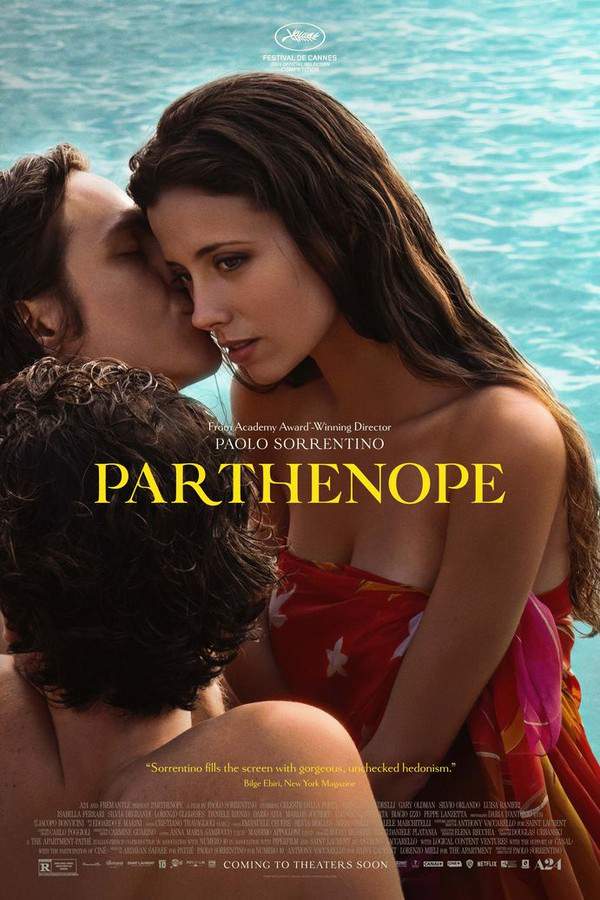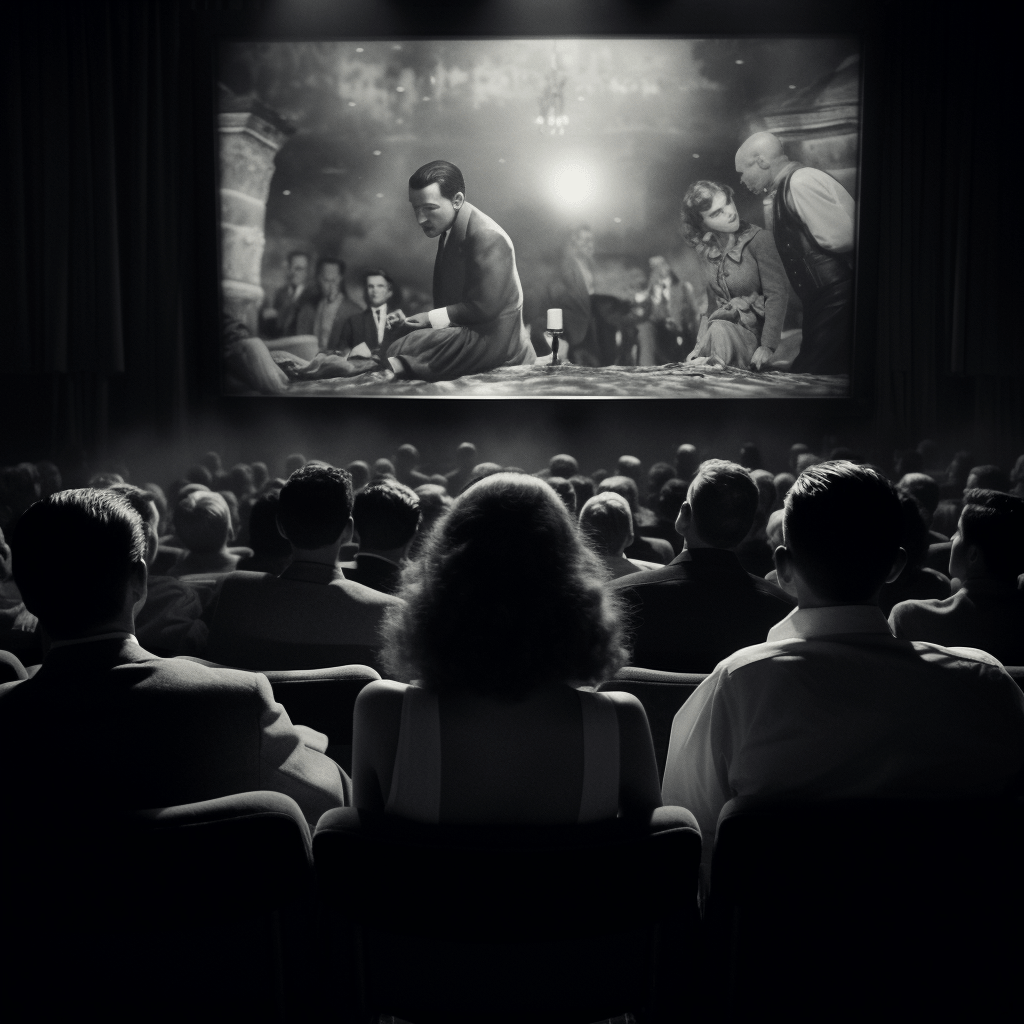What's After the Blog?
Opinions
Parthenope: A Beautifully Confusing Masterpiece or Just Pretentious?
Paolo Sorrentino’s *Parthenope* is stunning but perplexing. Is it a profound meditation on self-discovery or just cinematic indulgence?
February 7, 2025

Movies mentioned in this article
Parthenope: A Beautifully Confusing Masterpiece or Just Pretentious?
“Beauty is like war: It opens doors.”
— John Cheever (as portrayed by Gary Oldman in Parthenope)
Paolo Sorrentino’s Parthenope can feel like an extravagant feast of images, offering rich servings of cinematic grandeur tempered by moments of confounding excess. During one scene, the film’s languid contemplation of a blossoming romance feels hypnotic; minutes later, it ventures into episodes that risk drowning the viewer in visual overindulgence. This duality—beauty meshed with underlying frustration—has some calling the project a “masterpiece,” while others dismiss it as more self-indulgent than soulful.
Certain viewers might find this blend of mythic references, whimsical surrealism, and disquieting family drama thrilling. Others could walk away sensing that Parthenope is both enamored with its heroine’s allure and uneasy about how that allure overshadows her deeper qualities. Each viewer might discover a different dimension of the film, whether that’s an inspired commentary on the challenges faced by a brilliant woman or a tangled attempt at confronting the “male gaze.” Whichever side one leans toward, Parthenope has a knack for stirring conversation.
Plot & Themes
The film centers on Parthenope (portrayed by newcomer Celeste Dalla Porta from her late teens until she’s in her mid-thirties, then by iconic actress Stefania Sandrelli in older age). The character emerges like a siren from the sea—captivating not only viewers but nearly every other character in the story. Her older brother Raimondo’s painful obsession, a possible romantic entanglement with her childhood friend Sandrino, and half-dozen side stories involving mobsters, acting instructors, bishops, and a morose John Cheever (Gary Oldman) fill out the narrative tapestry.
At times, these threads spark genuine curiosity. A drunken Cheever doling out cryptic wisdom on love and war can feel both absurd and strangely poignant. The synergy of academic anthropology—Parthenope’s chosen field—and raw Neapolitan street life provides a vivid contrast between high-minded inquiry and brutal, sometimes scandalous realities. Yet the film’s fragmentary nature leaves you constantly wondering if these encounters will converge into a more profound statement or simply remain scattered vignettes.
A City, A Goddess, A Name
The name “Parthenope” is drawn from Greek mythology, once associated with Naples itself, so the city in this film is far more than a mere backdrop. Its streets and coastal panoramas echo many of Parthenope’s internal struggles: worshipped and desired on one side, yet also misunderstood or resented on another. Through Sorrentino’s lens, Naples embodies the same intense dualities that define his protagonist.
Some scenes exude an ethereal quality that recalls classic Italian cinema: swirling cameras capturing lively parties, or silent shots of the Bay of Naples that resemble Renaissance paintings. Other moments peel back the glamour to expose a more jaded undercurrent. In these sequences, cunning gangsters operate with understated menace, or lecherous bishops entwine religion with carnal impulses, ensuring that Parthenope rarely indulges in postcard sentiment without acknowledging the darker shadows beyond its luminous surface.
The Cast & Characters
Parthenope (Celeste Dalla Porta)
She arrives on screen almost as a mythic entity, surrounded by an aura that commands every gaze. Many of the film’s compositions highlight her against sweeping backdrops, emphasizing her inherent allure. Beneath that magnetic exterior, she wrestles with her own grief, social pressures, and academic dreams. Even so, the camera—and every man in her radius—can’t help but gravitate toward her image. The film oscillates between exploring her intellect and risking the same objectification it critiques.
Raimondo (Daniele Rienzo)
Raimondo is tormented by deep, unresolved longing. Scenes of his interior life provide flickers of raw heartbreak, yet the narrative only occasionally addresses the full depth of his despair. His character shows the unsettling influence Parthenope’s presence exerts even within a family relationship.
Sandrino (Dario Aita)
Sandrino serves as a calm anchor amid Parthenope’s turbulent orbit. As her childhood friend, he offers the gentler side of devotion, a companion who contrasts with more predatory or complex figures. His enduring affection remains one of the steadier threads in a film brimming with unsettled passions.
Professor Devoto Marotta (Silvio Orlando)
The sharp-tongued anthropology professor is among the few characters seemingly immune to Parthenope’s physical mystique. His role often centers on guiding her intellectual pursuits, though his clipped advice and abrupt manner can feel more like a narrative device than a fully fleshed-out persona.
John Cheever (Gary Oldman)
Oldman’s portrayal as the alcoholic writer has divided audiences between those finding it a gem of eccentric humor and those who label it a diversion that disrupts pacing. He underscores the film’s fascination with characters living on the edge of self-destruction, offering cryptic commentary on desire and war.
Supporting characters—a gangster with hypnotic menace, a bishop conflating worship and lust, a revered actress hiding behind a mask to shield her own regrets—round out Sorrentino’s carnival of personalities. Each brief appearance reinforces the sense that Naples is a world where grandeur, corruption, faith, and vice mingle without clear borders.
Beauty vs. Depth: What’s Sorrentino Really Saying?
One motif resonates clearly: the power of beauty to dominate attention. Extended shots linger on Parthenope’s face and form, with countless onlookers in thrall. Yet the film also alludes to her deeper quest—for knowledge, for escape from her brother’s possessive adoration, for a voice beyond her physical allure. The push and pull between these aims becomes a driving tension in Parthenope, raising the question of whether Sorrentino is celebrating a woman’s complexity or unwittingly reducing her to a symbol.
Moments of introspection—often set against an anthropological framework—suggest that Parthenope is scrutinizing her own environment as much as we are scrutinizing her. However, these quieter revelations sometimes risk being overshadowed by the film’s sumptuous dedication to aesthetic pleasure.
The Debate Over the “Male Gaze”
Much of Parthenope’s drama arises from its attempts to position a strong female lead within a cinematic language that can’t resist spotlighting her desirability. The tension is pervasive: does the film simply comment on how our world objectifies women, or is it complicit in that objectification?
Some viewers argue that Sorrentino intentionally makes Parthenope’s magnetism a reflection of how society can’t see past someone’s appearance, while others see a film enamored with its own protagonist, hesitating to grant her the agency it seems to promise. This dichotomy provides a rich vein of interpretive possibilities—many of which hinge on individual tolerance for contradictory storytelling.
Is It Worth Watching?
Certain segments of the audience hail Parthenope as a lush cinematic poem. Others find it indulgent, with scenes that linger too long on visual spectacle. Those enthralled by Sorrentino’s opulent style and elliptical storytelling will appreciate the grand set pieces, the unexpected humor, and the undercurrent of melancholy coursing through the film. Anyone seeking a more straightforward narrative or preferring earnest clarity might come away feeling that the director’s ornate flourishes obscure a stronger core message.
If you want to see what other people think of Parthenope, Metacritic, Rotten Tomatoes, IMDb, TMDB, Wikipedia, JustWatch, Box Office Mojo, and Movie Insider all host diverse takes from both casual viewers and fervent cinephiles. Collectively, these sources offer broader insight into Parthenope’s reception and the debates it ignites.
Where to Learn More & Join the Conversation
In a film as sprawling as Parthenope, there’s always more to untangle. What’s After the Movie has taken up that challenge by providing detailed analyses and supplementary content. Visitors to the blog can find synopses to clarify the timeline, character lists clarifying who’s who in the story, and quizzes exploring recurring motifs and controversies.
For an even deeper look into Sorrentino’s grand tapestry, a dedicated page explores Parthenope at
https://www.whatsafterthemovie.com/movies/parthenope.
There, readers can delve into extra trivia, behind-the-scenes tidbits, and accessible links to other platforms.
Final Thoughts
In Parthenope, Sorrentino wields the tools he’s known for—sweeping camerawork, decadent style, the commingling of the sacred and the profane—with characteristic flair. Whether this particular creation resonates as profound or hollow may depend on individual tastes and thresholds for visual indulgence. One can hardly deny the emotional force in a shot of sunlit waters reflecting off Parthenope’s pensive face, or the moment when a raucous Neapolitan festival abruptly shifts into a surreal crisis of faith and lust.
Though it revels in ambiguity, Parthenope consistently nudges audiences to contemplate beauty’s power to enthrall or destroy, along with the ways in which both society and the camera might distort a woman’s quest for self-actualization. Regardless of one’s final assessment, the film rarely leaves a viewer indifferent. It stands as another bold statement from an Italian filmmaker who thrives on exploring life’s contradictions—always with a flourish that’s as splendid as it is provocative.
Continue reading

What's After the Movie?
Not sure whether to stay after the credits? Find out!
Explore Our Movie Platform
New Movie Releases (2025)
Famous Movie Actors
Top Film Production Studios
Movie Plot Summaries & Endings
Major Movie Awards & Winners
Best Concert Films & Music Documentaries
Movie Collections and Curated Lists
© 2025 What's After the Movie. All rights reserved.







